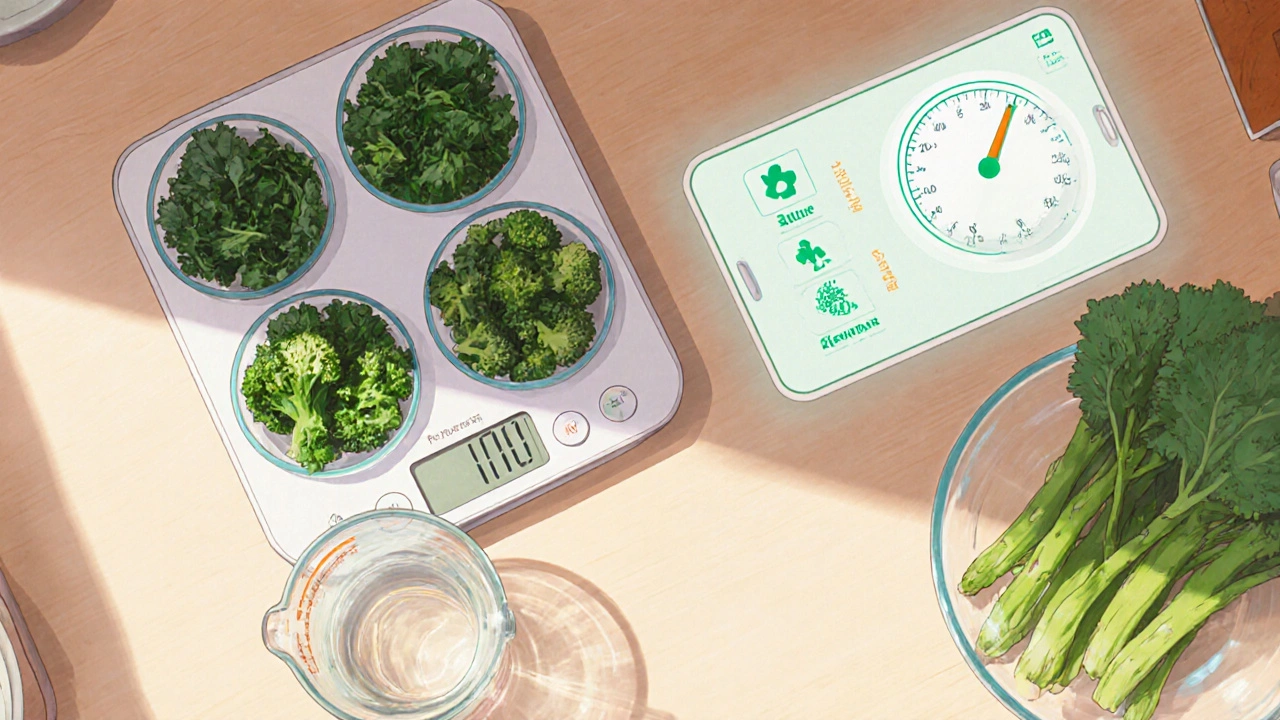Vitamin K Tracker for Warfarin Patients
Daily Vitamin K Tracker
Track your vitamin K intake to maintain stable INR levels between 2.0 and 3.0. Aim for 90-120 µg daily with less than 20% variation.
Your Current Intake
Daily Summary
Target Range: 90-120 µg
Consistency Target: ±20%
Daily vitamin K intake
0.0 µg
Finding the sweet spot between eating the foods you love and keeping your blood thin enough can feel like walking a tightrope. The good news? You don’t have to ditch all green veggies. By learning how vitamin K interacts with your warfarin diet and adopting a steady eating plan, you can keep your INR in range and avoid scary dose swings.
What Warfarin Is and How It Works
Warfarin is a synthetic anticoagulant that blocks the enzyme vitamin K epoxide reductase, which is needed to activate clotting factors II, VII, IX, and X. By limiting these factors, warfarin reduces the risk of clots in conditions like atrial fibrillation and deep‑vein thrombosis. It’s cheap (about $4‑$10 a month for the generic) and has a reliable reversal protocol, which is why it’s still prescribed to millions of patients despite newer direct oral anticoagulants (DOACs).
Why Vitamin K Matters
Vitamin K is a fat‑soluble vitamin that exists mainly as K1 (phylloquinone) in leafy greens and as K2 (menaquinones) in animal products and fermented foods. Vitamin K is the cofactor that lets the clotting cascade finish its job. When you eat more vitamin K, your body can produce more clotting factors, which in turn lowers the effect of warfarin and drops your INR.
Studies show that a daily intake above 250 µg can cut warfarin sensitivity, pulling the INR down by about 0.5‑1.0 units within three to five days. Conversely, dropping your vitamin K intake by half can raise the INR by a similar amount.
INR: The Numbers That Matter
The International Normalized Ratio (INR) is a blood test that measures how long it takes your blood to clot compared with a standard. Most warfarin patients aim for an INR between 2.0 and 3.0. Anything outside that range means your dose may need adjustment-too low and you risk clots; too high and you risk bleeding.
Consistency Beats Restriction
Older advice told patients to avoid all green veggies. Modern guidelines from the American Heart Association and the American College of Cardiology say the opposite: keep your vitamin K intake steady, roughly 90‑120 µg per day, and avoid wild swings.
Why? A 2019 WARIS II sub‑analysis found that patients who kept day‑to‑day vitamin K variation under 20% achieved a Time in Therapeutic Range (TTR) of 75‑80%. Those with big ups and downs hovered around a 55‑65% TTR.
In practice, that means you can enjoy kale, spinach, broccoli, and collard greens-just don’t suddenly double or triple your portions.

High‑K Foods You’ll Encounter
| Food | Vitamin K (µg) | Typical Portion for Consistency |
|---|---|---|
| Kale | 547 | ¼ cup cooked (≈135 µg) |
| Spinach | 889 | ⅓ cup cooked (≈300 µg) |
| Collard Greens | 772 | ¼ cup cooked (≈190 µg) |
| Broccoli | 220 | ½ cup cooked (≈110 µg) |
| Asparagus | 70 | ½ cup cooked (≈35 µg) |
| Green Beans | 14 | ½ cup cooked (≈7 µg) |
Notice how cooking concentrates vitamin K dramatically. Raw spinach only has about 145 µg per cup, while the same amount cooked jumps to 889 µg.
Building a Consistent Vitamin K Plan
- Pick Your Core Veggie. Choose one high‑K vegetable you like-say, ¼ cup cooked kale daily.
- Measure Portions. Use a kitchen scale or measuring cups so you know exactly how many micrograms you’re getting.
- Log Every Meal. Write down the amount in a notebook or a phone app (see tools below).
- Stay Within 20% Variation. If you usually eat 135 µg of kale, don’t jump to 400 µg on a special night without telling your clinic.
- Review Weekly. Compare your logs with your INR results. Small trends often show up before a dose change is needed.
Most patients need 8‑12 weeks to lock in a routine. During that period, INR stability typically improves about 5 % TTR per month.
Tools That Make Tracking Easy
- CoumaDiet: a free app that cross‑references USDA data and flags when you’re over your target vitamin K range.
- INR Tracker Pro: used by many anticoagulation clinics; it integrates your food log with dose‑prediction algorithms.
- Simple spreadsheet: create columns for date, food, portion, µg K, and notes. Color‑code days when INR drifts.
- Paper food diary: the Mayo Clinic handout lists 50 common foods with exact vitamin K values-great for quick reference.
Whichever method you pick, consistency of logging matters as much as consistency of intake.

When Consistency Isn't Enough
Some patients still struggle with wildly swinging INRs despite a steady diet. In those cases, clinicians may consider a low‑vitamin‑K strategy (under 70 µg/day) as a last resort, but only after ruling out drug interactions, antibiotic use, and illness‑related appetite loss.
Supplements that contain vitamin K-like certain multivitamins-should be avoided unless prescribed. Even a modest 50 µg boost can shift INR by 0.2‑0.3 units.
Key Takeaways
- Aim for 90‑120 µg of vitamin K per day and keep daily variation under 20%.
- Pick one or two high‑K veggies, measure portions, and stick with the same amount each day.
- Log meals with an app or notebook and review against your INR results weekly.
- Use tools like CoumaDiet or INR Tracker Pro to catch hidden sources of vitamin K.
- If INR stays unstable, talk to your clinician about possible low‑K strategies or medication adjustments.
Frequently Asked Questions
How many micrograms of vitamin K are in a typical salad?
A 2‑cup mixed green salad (mostly lettuce) usually provides 30‑50 µg of vitamin K. Adding a half‑cup of cooked kale bumps it up to about 135 µg.
Can I eat vitamin K‑rich foods on days I don’t take warfarin?
Warfarin is taken daily, so your intake should be steady every day. Skipping vitamin K one day and loading it the next can cause the INR to swing unexpectedly.
Do antibiotics affect my vitamin K balance?
Yes. Broad‑spectrum antibiotics can kill gut bacteria that produce vitamin K2, reducing overall vitamin K by up to 70 % and potentially raising INR. Notify your clinic if you start a course of antibiotics.
Is it safe to take a multivitamin that contains vitamin K?
Only if your clinician approves. Many over‑the‑counter multivitamins have 30‑100 µg of vitamin K, which can change your INR without you realizing it.
What should I do if my INR falls below 2.0 after a big veggie meal?
Contact your anticoagulation clinic right away. They may ask you to hold the next dose or adjust it slightly. In the meantime, keep your vitamin K intake consistent.
Balancing warfarin and vitamin K isn’t about saying “no greens.” It’s about understanding how much you eat, logging it, and staying within a narrow band day after day. With a steady plan and the right tracking tools, you’ll keep your INR in range and enjoy the foods you love.

Buddy Bryan
Warfarin isn’t a mystery, it’s chemistry you can master. Keep your vitamin K intake around the same amount every day and you’ll stop the roller‑coaster INR swings. Measure your kale portion-about a quarter cup cooked gives roughly 135 µg, that’s a solid baseline. Log it religiously, the app will flag any surprise spikes before they hit your clinic. If you notice a jump of more than 20 % in your weekly logs, call your anticoagulation nurse and ask for a dose tweak right away.
Consistency beats restriction, period.
Jonah O
They don’t want you to know that the pharma giants secretly push warfarin because it lines their pockets while the “new” DOACs get hidden behind patent walls. The real agenda is to keep patients tangled in endless food‑tracking apps so the system stays profitable.
Sure, the guidelines say 90‑120 µg K daily, but they also sprinkle hidden vitamin K in processed foods you never suspect. Keep an eye on those “low‑sodium” soups-they’re often fortified with vitamin K‑rich extracts. Trust your own logs more than the glossy brochures, because the truth is out there.
Aaron Kuan
Kale spikes INR, keep it steady.
Benjamin Sequeira benavente
Listen up, the only thing you need to conquer is your own routine. Grab a kitchen scale, measure that kale, and log it like a champ. Every day you stick to the same µg count you’re one step closer to a stable INR. No conspiracy, just plain discipline. You’ve got the power to outsmart the system-start today!
Nathan Comstock
When you think about warfarin you have to remember that this is an American triumph over bleeding chaos. Our doctors have honed the perfect balance of science and grit, and that legacy can’t be thrown away for some foreign fad. The vitamin K tables you see are a testament to the meticulous research funded by our own institutions, not some overseas cabal. If you stray from the 90‑120 µg range, you’re basically sabotaging the very freedom our country stands for. Consistency isn’t just a medical suggestion; it’s a patriotic duty. The moment you double your kale portion on a Sunday dinner, you risk undoing weeks of careful dose adjustments that were calibrated by American expertise. Your INR may dip below 2.0, and suddenly you’re facing the same dangers our forefathers fought against-clots, strokes, and a loss of liberty in your own bloodstream. Keep your diet steady, and you honor the very doctors who swore an oath on this land. The tools like CoumaDiet are built right here, designed to keep you in the therapeutic sweet spot. Don’t let a random trend convince you to abandon what works. Remember, every time you log a meal, you’re reinforcing the American spirit of order and reliability. The next time a news article whispers about “newer” anticoagulants, ask yourself if it’s truly better or just a marketing ploy. Your health is the ultimate flag you fly, and a stable INR is the banner that waves proudly. So, stick to the plan, respect the numbers, and keep the American standard of care alive in your kitchen.
Stay strong, stay consistent, stay American.
Amber Lintner
Oh, please! The whole “patriotic duty” spiel is just a thin veil for fear‑mongering. Who decided that a quarter cup of kale is a sacred relic of liberty? I’d rather taste life than worship a spreadsheet. Throw the guidelines out the window and eat whatever you damn well please-let the INR rise, let it fall, it’s all just a drama we’ve been forced to act out. Your “American triumph” is nothing more than a convenient excuse to control our plates.
Lennox Anoff
It is a gross moral failing to reduce the intricate interplay of coagulation pathways to mere “consistency” slogans. One must approach the warfarin regimen with a philosophic humility, recognizing the ethical weight of each micronutrient decision. The reductionist tables, while scientifically useful, betray a neoliberal commodification of health, transforming our bodily autonomy into a transactional ledger. To truly honor the sanctity of life, we must scrutinize not only our kale portions but also the sociopolitical structures that dictate dietary norms.
Only then can we aspire to a genuinely enlightened anticoagulation practice.
Olivia Harrison
I hear you, and it’s true that the science can feel impersonal at times. But the practical tools we have-like food logs and the INR tracker-can actually empower us to take back that control. By writing down each portion, we make the abstract numbers tangible, and that can bring a sense of peace. If you ever need a simple template or a friendly chat about how to balance your greens, just let me know. We’re all in this together, and your well‑being matters.
Bianca Larasati
Let’s get pumped about those veggie portions! 🎉 Pick your favorite high‑K green, measure it, and repeat it like a workout routine. The more you nail that daily 90‑120 µg target, the stronger your INR will stay, and the more confidence you’ll feel in every meal. Celebrate each consistent day with a small victory-maybe a smoothie or a quick dance break. You’ve got the power to turn food tracking into a fun, unstoppable habit!
Corrine Johnson
Indeed, the act of measuring, of quantifying, of imposing order upon the chaos of nutrients, is a profound ritual, a micro‑cosm of humanity’s eternal quest for meaning; it is, perhaps, the very embodiment of the Platonic ideal of the Forms, transmuted into the kitchen, into the bloodstream, into the very pulse of existence.
When you celebrate each consistent day, you are not merely marking a health milestone, you are, in effect, honoring the dialectic between freedom and discipline, a balance that, according to Aristotle, is the golden mean of virtuous living.
Thus, your dance break is not simply a frivolous movement, but a symbolic affirmation of the harmonious convergence of body and mind.
Jennifer Stubbs
Analyzing the data from the tables, the variance in vitamin K content between raw and cooked greens is significant, with cooking increasing the µg per cup by up to sixfold. This indicates that patients who track only raw portions may underestimate their intake dramatically. Moreover, the recommended 20 % daily variation threshold translates to roughly ±20–30 µg for most patients, a narrow window that requires precise measurement tools. Cross‑referencing this with INR trends often reveals a lag of two to three days before the lab reflects dietary changes. Therefore, integrating a real‑time logging app with automated alerts can preemptively flag potential swings, allowing clinicians to adjust doses before dangerous excursions occur.
In practice, a simple spreadsheet with conditional formatting can achieve similar results for those without app access.
Abhinav B.
Totally agree, data is king, but many patients in our community still rely on memory, not spreadsheets. We need more outreach, more easy‑to‑use tools that fit local kitchens, especially where measuring cups are rare. Also, watch out for local dishes that hide K‑rich ingredients-those hidden veggies can wreck your INR fast. Let’s push for education in regional languages, make the apps multilingual, and fix the gaps now.
Otherwise the system stay broken.